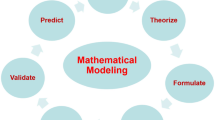Abstract
Mathematical biology education provides key foundational underpinnings for the scholarly work of mathematical biology. Professional societies support such education efforts via funding, public speaking opportunities, Web presence, publishing, workshops, prizes, opportunities to discuss curriculum design, and support of mentorship and other means of sustained communication among communities of scholars. Such programs have been critical to the broad expansion of the range and visibility of research and educational activities in mathematical biology. We review these efforts, past and present, across multiple societies—the Society for Mathematical Biology (SMB), the Symposium on Biomathematics and Ecology Education and Research (BEER), the Mathematical Association of America (MAA), and the Society for Industrial and Applied Mathematics (SIAM). We then proceed to suggest ways that professional societies can serve as advocates and community builders for mathematical biologists at all levels, noting that education continues throughout a career and also emphasizing the value of educating new generations of students. Our suggestions include collecting and disseminating data related to biomath education; developing and maintaining mentoring systems and research communities; and providing incentives and visibility for educational efforts within mathematical biology.
Similar content being viewed by others
References
AAMC-HHMI Committee (2009) Scientific Foundations for Future Physicians, Association of American Medical Colleges and Howard Hughes Medical Institute. https://www.hhmi.org/sites/default/files/Programs/aamc-hhmi-2009-report.pdf. Accessed 29 April 2020
Adler F, Gross L, Kerkhoff A, Mahaffy J, Galovich J (2015) (Chair), Report from the Program Area Study Group on Mathematical Biology, 2015 CUPM (Committee on the Undergraduate Program in Mathematics) Curriculum Guide, The Mathematical Association of America. https://www.maa.org/sites/default/files/MathBioPASGReport.pdf. Accessed 29 April 2020
BIO SIGMAA (2006) Charter. https://qubeshub.org/community/groups/biosigmaa/charter. Accessed 29 April 2020
Boyer EL (1990) Scholarship reconsidered: priorities of the professoriate. Princeton University Press, Lawrenceville
de Vries G, Hillen T, Lewis M, Müller J, Schönfisch B (2006) A course in mathematical biology: quantitative modeling with mathematical and computational methods. The Society for Industrial and Applied Mathematics, Philadelphia
Goring SJ, Weathers KC, Dodds WK, Soranno PA, Sweet LC, Cheruvelil KS, Kominoski JS, Rüegg J, Thorn AM, Utz RM (2014) Improving the culture of interdisciplinary collaboration in ecology by expanding measures of success. Front Ecol Environ 12:39–47. https://doi.org/10.1890/120370
Ledder G (ed) (2008) Special issue: integrating mathematics and biology. PRIMUS (Problems, Resources, and Issues in Mathematics Undergraduate Studies) 18:1–138
Ledder G, Carpenter JP, Comar TD (eds) (2013) Undergraduate Mathematics for the Life Sciences: Models, Processes, and Directions. The Mathematical Association of America, Washington
Lucas HL (ed) (1962) The Cullowhee conference on training in biomathematics: an international conference held at Western Carolina College, Cullowhee, North Carolina, August 14–18, 1961, Raleigh, NC
National Research Council (2003) Bio 2010: transforming undergraduate education for future research biologists. National Academics Press, Washington
Pfirman S, Martin PJS (2017) Facilitating interdisciplinary scholars. The Oxford handbook of interdisciplinarity, 2nd edn. Oxford University Press, Oxford
QUBES (2019) Quantitative undergraduate biology education and synthesis. https://qubeshub.org/. Accessed 16 September 2019
SIAM Life Sciences page. https://www.siam.org/research-areas/detail/life-sciences. Viewed 10 March 2020
The Society for Mathematical Biology (2020a). https://www.smb.org/. Accessed 29 April 2020
The Society for Mathematical Biology (2020b) Mentorship. https://www.smb.org/mentorship/. Accessed 29 April 2020
Steen LA (ed ) (2005) Math & Bio 2010: linking undergraduate disciplines. The Mathematical Association of America, Washington
Stepien T, Kostelich EJ, Kuang Y (2020) Mathematics + Cancer: an undergraduate “bridge” course in applied mathematics. SIAM Rev 62:244–263
Acknowledgements
The authors thank Victoria Booth, Leah Edelstein-Keshet, Lou Gross, John Jungck, Raina Robeva, Elissa Schwartz, and Robert Smith? for conversations and input in support of this article.
Author information
Authors and Affiliations
Corresponding author
Additional information
Publisher's Note
Springer Nature remains neutral with regard to jurisdictional claims in published maps and institutional affiliations.
Rights and permissions
About this article
Cite this article
Greer, M.L., Akman, O., Comar, T.D. et al. Paying Our Dues: The Role of Professional Societies in the Evolution of Mathematical Biology Education. Bull Math Biol 82, 59 (2020). https://doi.org/10.1007/s11538-020-00728-9
Received:
Accepted:
Published:
DOI: https://doi.org/10.1007/s11538-020-00728-9




